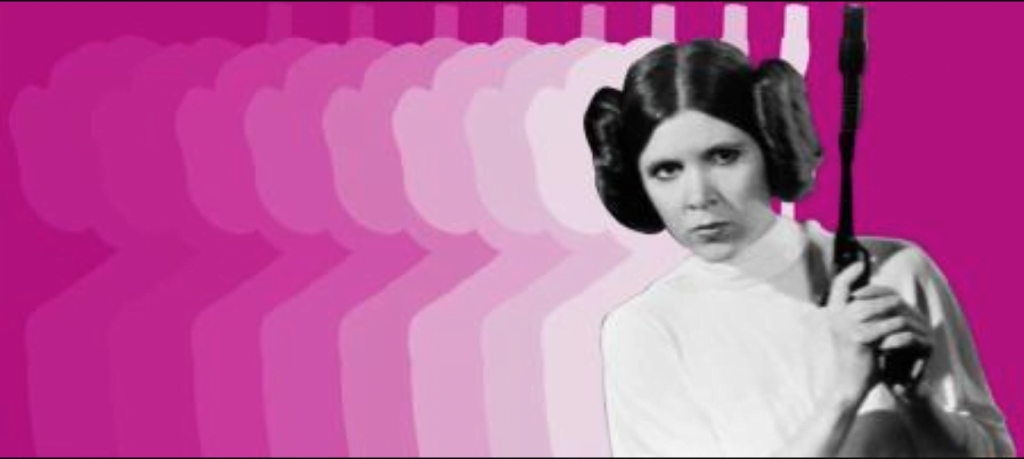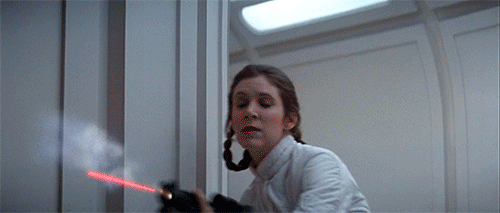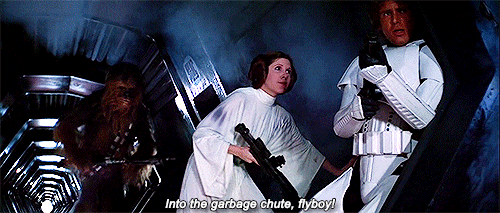
One of the most prominent heroines in all of cinema, General Leia Organa (aka Princess Leia) operated in a league of her own. From her blaster-handling capabilities to her strategic mind to her ability to protect and inspire those around her, Leia was more than a capable leader: she was totally boss.
She was more boss than her father, Darth Vader, who used fear and intimidation to rule.
She was more boss than her brother, Luke Skywalker, who harbored simplistic notions of organizational vision and eventually withdrew from the world.
She was more boss than her husband, Han Solo, whose brazen, blaster-blaring approach to life may have impressed us, but whose project management process was ultimately unsustainable.
Anyway, let’s cut the movie trivia chatter. Here are 10 reasons why Princess Leia was totally boss.
1. She was fearless, but not psychopathic.
Princess Leia did not hesitate to dive into a trash compactor, pilot a speeder bike through the dense forests of Endor or swing across a deep Death Star chasm on a flimsy wire. But she could also feel the pain of losing her home planet to the Empire’s cruelty, as well as the loss of her own son to the Dark Side.
Effective leadership demands a certain tolerance of risk, but also empathy. A 2016 study corroborated earlier research that 20 percent of CEOs and executives meet criteria for psychopathy, marked by callous and unemotional traits such as insincerity, a lack of empathy or remorse, egocentrism, charm and superficiality. (Want to find out your own tolerance for risk? Check out this Tech Republic article. Need to build some empathy? Please do.)
2. She had mad technical skills.
![]()
She knew machine learning before it was cool. While technical skills are not an absolute requirement for leading, say, a software development team, they do garner trust and respect, and they come in handy in a pinch.
3. She could accept change and adapt to shifting circumstances.
![]()
Before the Empire blew up her home planet, Alderaan, Leia lied and protested fiercely to her imperial captors, trying to save her people. And when they destroyed her planet anyway, she cried out, then almost immediately seemed to accept the loss and begin planning her next move. This balance of conviction and agility makes for great leadership: you have to believe in your ideas and be able to sell them, but also adjust course when things don’t go your way.
4. She could communicate.
![]()
Whether she was discussing strategy with leaders to attack the Death Star, inspiring her fellow rebels to win against all odds, or lying about where the rebel plans were hidden, Princess Leia knew her audience and exactly what to say at the right time. Her ability to craft a clear, compelling message with words made her an effective leader. The best leaders know how to write a sentence (see Abraham Lincoln, Winston Churchill, Martin Luther King, Jr., etc.). They don’t inflate their prose with polysyllabic jargon or passive voice in a certain-to-backfire attempt to sound intelligent. Rather, they strive to express, not impress. (For some handy tips to help your writing, check out Strunk & White’s old standby, The Elements of Style—or just cruise these two pages of free, expert advice from novelist Kurt Vonnegut.)
5. She could delegate.
![]()
Rather than try to deliver the Death Star blueprint Obi-Wan Kenobi on her own, she programmed R2-D2 to deliver the vital information. A good manager knows how to delegate tasks to their team. They trust and verify.
6. She could motivate.
Once, while fending off a swarm of Stormtroopers, Leia ordered Luke Skywalker and Han Solo to take refuge in a trash compactor. She knew the language to use to get through to her direct reports. Some workers are motivated by polite requests. Others need more forceful instruction (“Into the garbage chute, flyboy!”). Leia knew Han was the latter. A good leader takes their colleagues’ communication styles into account and fine-tunes the message accordingly.
7. She saw the bigger picture.
![]()
Leia knew the organization inside and out, cared deeply about her team and the larger mission, and could orchestrate tactics that optimized and harmonized the various talents of her underlings. She had a hand in everything, from the Rebels’ retreat from their secret Hoth base to commanding X-Wing pilots on their Death Star assault. Although too much involvement in projects can actually contravene good leadership, Leia brought a diverse enough skillset and knowledge base to the table that she could use her powers creatively, not disastrously.
8. She kept her sense of humor.
![]()
“Aren’t you a little short to be a stormtrooper?” “I don’t know where you get your delusions, laser brain.” “I know what you’re gonna say: I changed my hair.” No doubt about it, Leia was funny. She could deliver an absurdist jab or a bit of deadpan understatement perfectly. While not necessarily essential for good leadership, the ability to deploy a bit of well-timed humor can deflate tension, cultivate joy and build camaraderie. Note (this is crucial!): Princess Leia knew how to read her audience. She didn’t cross the line or go too far. If you’re currently unable to read a room, maybe take an improv class or do some standup open mics before trying out your wit at work.
9. She was thoughtful yet decisive when met with pressing expectations.
![]()
Leia could evaluate multiple courses of action and commit to one. She neither went with her gut nor overanalyzed urgent situations. She wasn’t afraid to push colleagues to step up their game when necessary. And, when her team succeeded, she didn’t hesitate to publicly praise them, as in the awards ceremony scene that closes A New Hope. Great managers do likewise. They don’t coddle their teammates, but they don’t withhold recognition or encouragement either. They create and sustain an atmosphere of openness, accountability and support.
10. She believed in herself and her team.
![]()
Everything Leia did oozed self-belief and devotion to a higher cause. As the bedrock of all leadership, self-confidence and team trust are necessary (but not sufficient) conditions for success. This is not cockiness or over-optimism, but a kind of energy source that feeds innovation and sustains morale. (If you need to ramp up that self-belief, try mindfulness meditation. It works, seriously. Side benefit: massive reduction in anxiety.)
How about you?
Could your leadership skills use some growth or intervention? AIM Institute offers two leadership development programs specifically designed with IT professionals in mind.
If you, like Leia, want to be both boss (adjective) and the boss (noun), the foundational AIM IT Emerging Leaders Program and the more intensive IT Leadership Academy provide pathways to effective IT management. Over the years, hundreds of students have built the skills they need to move from technical positions into management. Check out this page for more information.
AIM’s Emerging Leaders Program spring session has moved from an in-person modality to an online one. The class begins April 23. Sign up now through Eventbrite!
Questions? Contact Monika Philp at monika@nullaimsite1.wpenginepowered.com.
(Note: this article was co-written with Matt Swanson, Marketing Coordinator for the AIM Institute. Featured photo comes from Emily L. Hauser’s excellent article for The Week, “Princess Leia, feminist hero.”)
